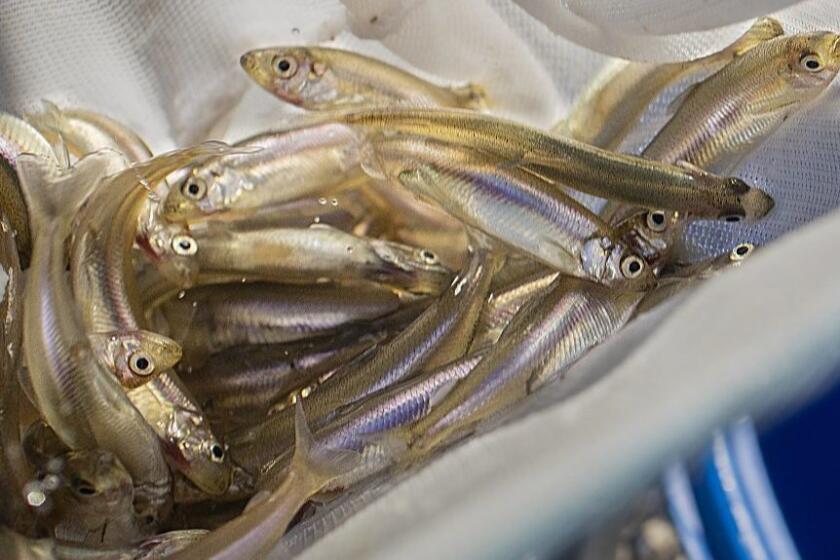
- Share via
SHOSHONE, Calif. — It was just before sunrise in July when the botanists Naomi Fraga and Maria Jesus threw on backpacks and crunched their way across a brittle alkaline flat in the hottest corner of the Mojave Desert. Their mission: to rescue a tiny plant teetering on the brink of extinction.
A decade ago, the Amargosa River Basin east of Death Valley National Park was a vast muddy wetlands studded with millions of Amargosa niterwort, a fleshy herb that grows only here and that scientists call Nitrophila mohavensis.
Today, the species has dwindled to fewer than 150,000, and most of the plants that still sprout from this salt-white playa have stopped producing viable seeds — stressed victims of decreasing rainfall, rising temperatures and the loss of groundwater due to pumping.
The botanists aimed to collect seeds until the temperature hit triple digits. Later, their bounty would be sealed inside aluminum foil packets for storage in California Seed Bank freezers at the nonprofit California Botanic Garden in Claremont.
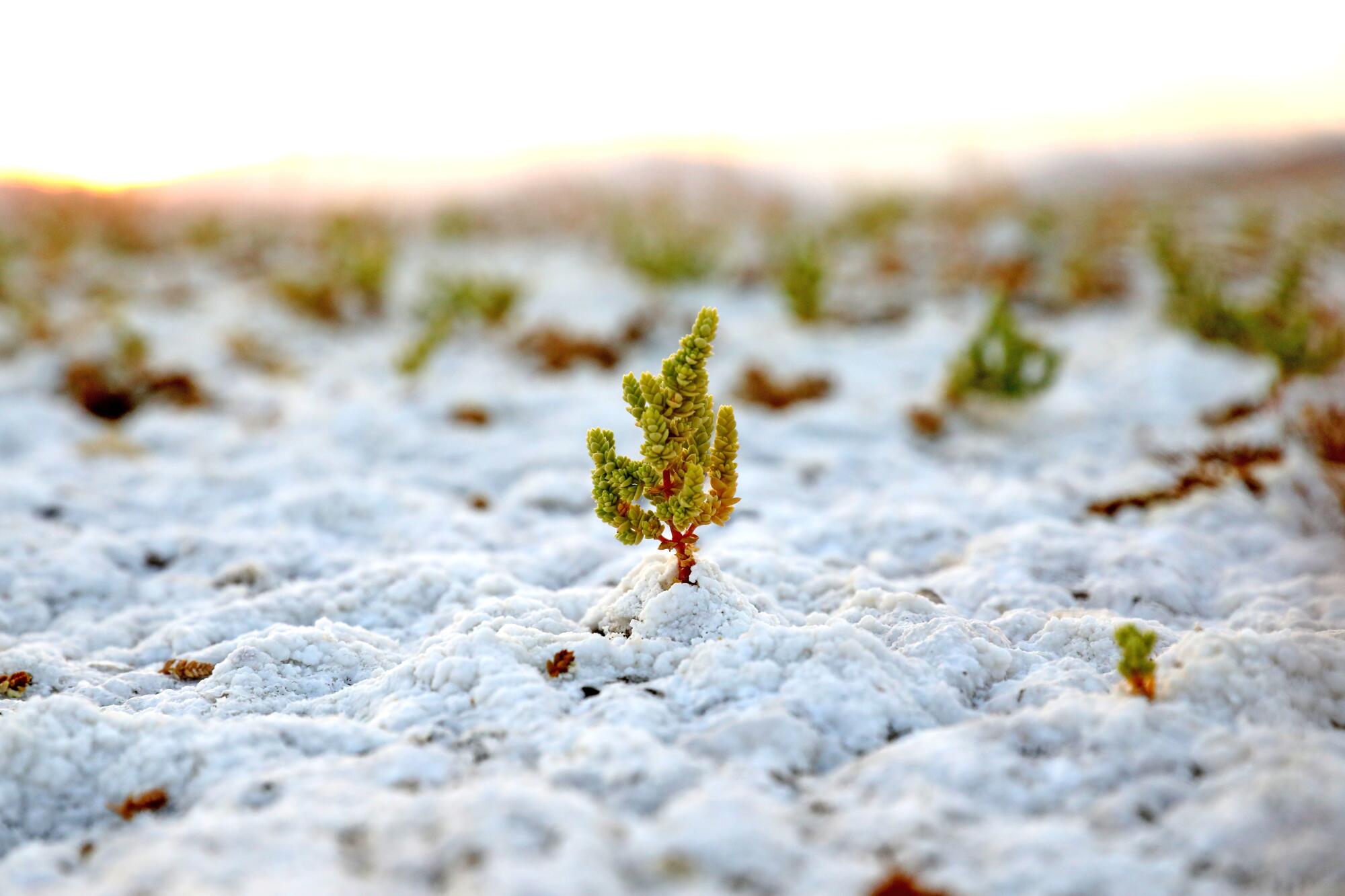
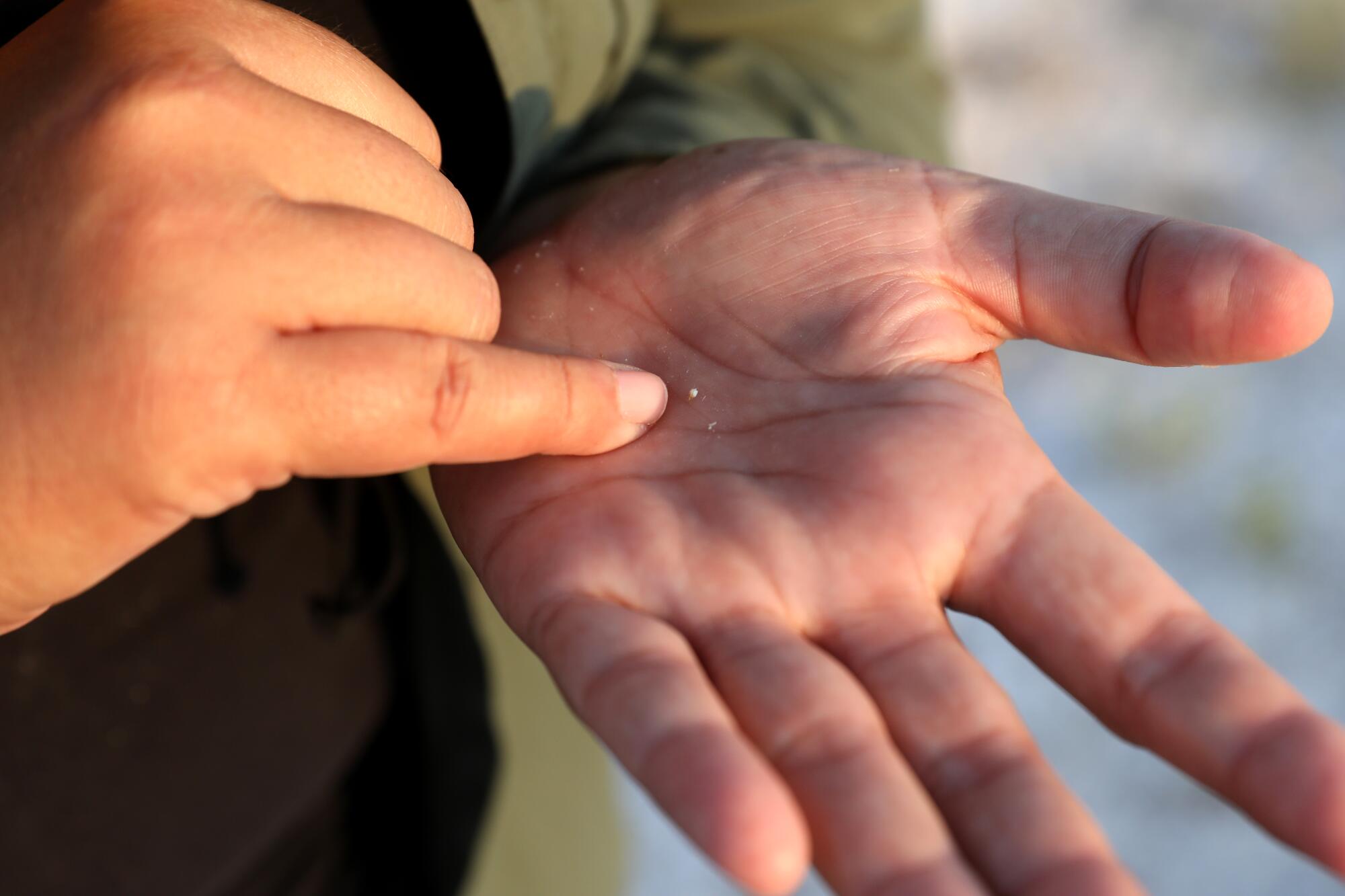
“Oh, man, I’ve never seen it so dry here before,” said Fraga, 42, director of conservation programs at the botanic garden. “Not all that long ago we would have been slipping and sliding around in mud,” she said.
Surrounding Fraga were shallow holes that had been dug by wildlife clawing desperately for food and water. “We’ll be lucky to find a single seed this morning,” she said.
The conditions under which Fraga and Jesus, 37, a conservationist at the botanic garden, were working said a lot about their spirit and commitment to salvaging even the most obscure flora whose natural cycles have fallen out of sync due to climate change.
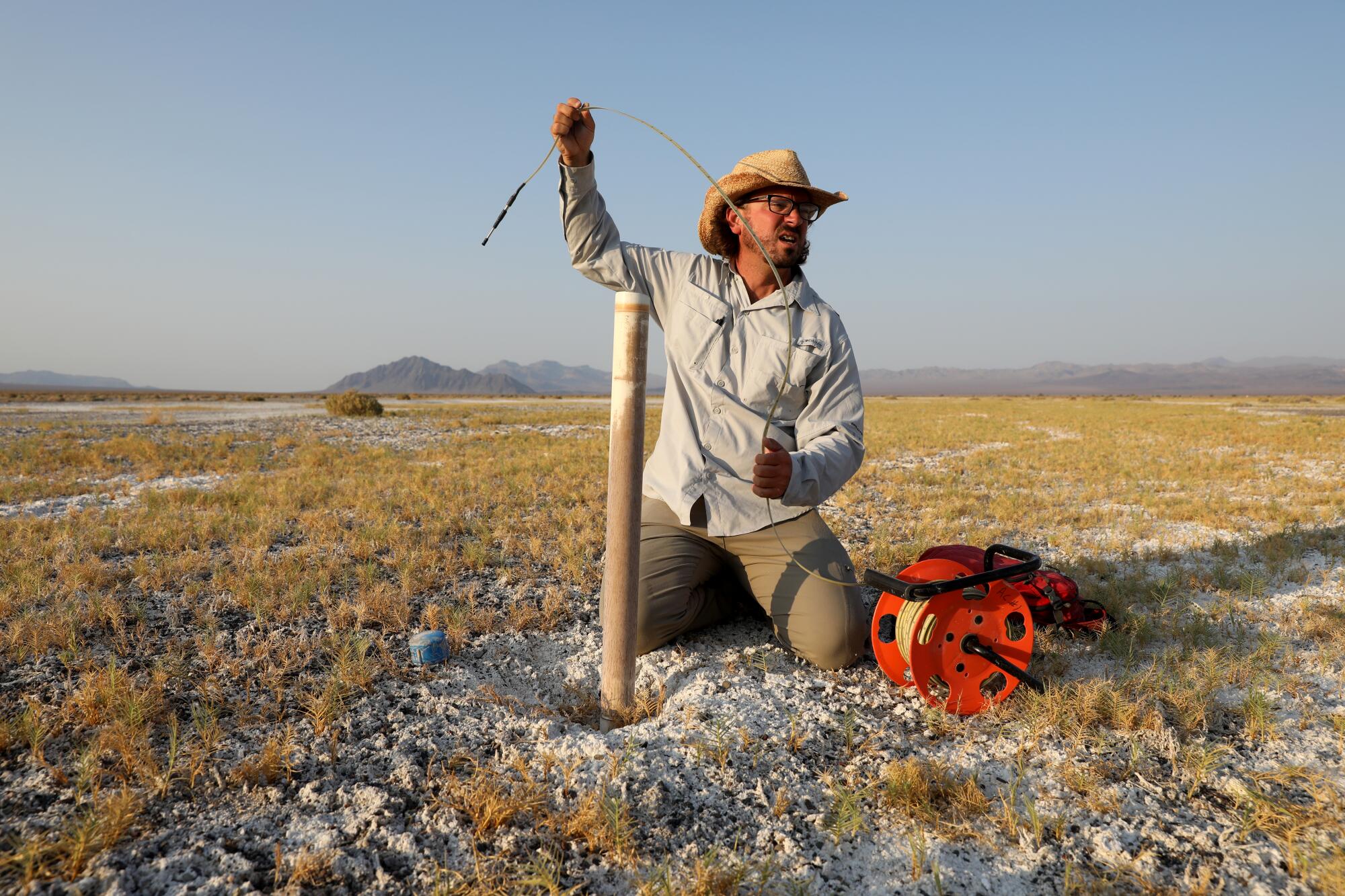
In four previous expeditions here, Fraga had collected a total 133 niterwort seeds. “Eventually, we’d like to have 3,000 of their seeds in the bank,” she said. “That would ensure enough on hand for restoration efforts if the plant has gone extinct in the wild.”
The recent survey left her doubtful however.
“The speed at which this desert is drying up makes me want to cry,” she said.
* * *
Globally, more than a million plants and animals face extinction due to habitat loss, climate change and other factors related to human activity, and this alarming loss of biodiversity is only accelerating. In California, conservationists and biologists have identified scores of species in potential peril, including many icons of the state’s beloved wildlands — chinook salmon, giant sequoias, Joshua trees, desert tortoises, California red-legged frogs, gray whales.
Now, a hellish summer of extreme fire activity, drought and heat are again pushing some species to the brink of oblivion. Seized by a newfound urgency, state and federal biologists, research institutions, conservation organizations and zoos have been racing to save the most threatened species with a bold campaign of emergency translocations, captive breeding programs and seed banks. Some have likened the effort to a modern-day Noah’s Ark.
“I can’t think of a single terrestrial ecosystem that’s not being stressed to the limits of its physiological tolerance right now,” said Dan Cooper, a consulting biologist and expert on the plants and animals of Los Angeles County.
A new United Nations report warning of a global extinction crisis identifies three parts of the world in particular danger: South America, Africa and parts of Asia.
Several all-out rescue efforts are taking place across the Amargosa River area, a region of eerily flat arid vistas, isolated oases, streams and rugged mountain ranges between Death Valley National Park and Mojave National Preserve. It is home to 61 endemic species, including four species of cave-dwelling insects that feed on crickets and scorpions that tumble down into their dark lairs from above.
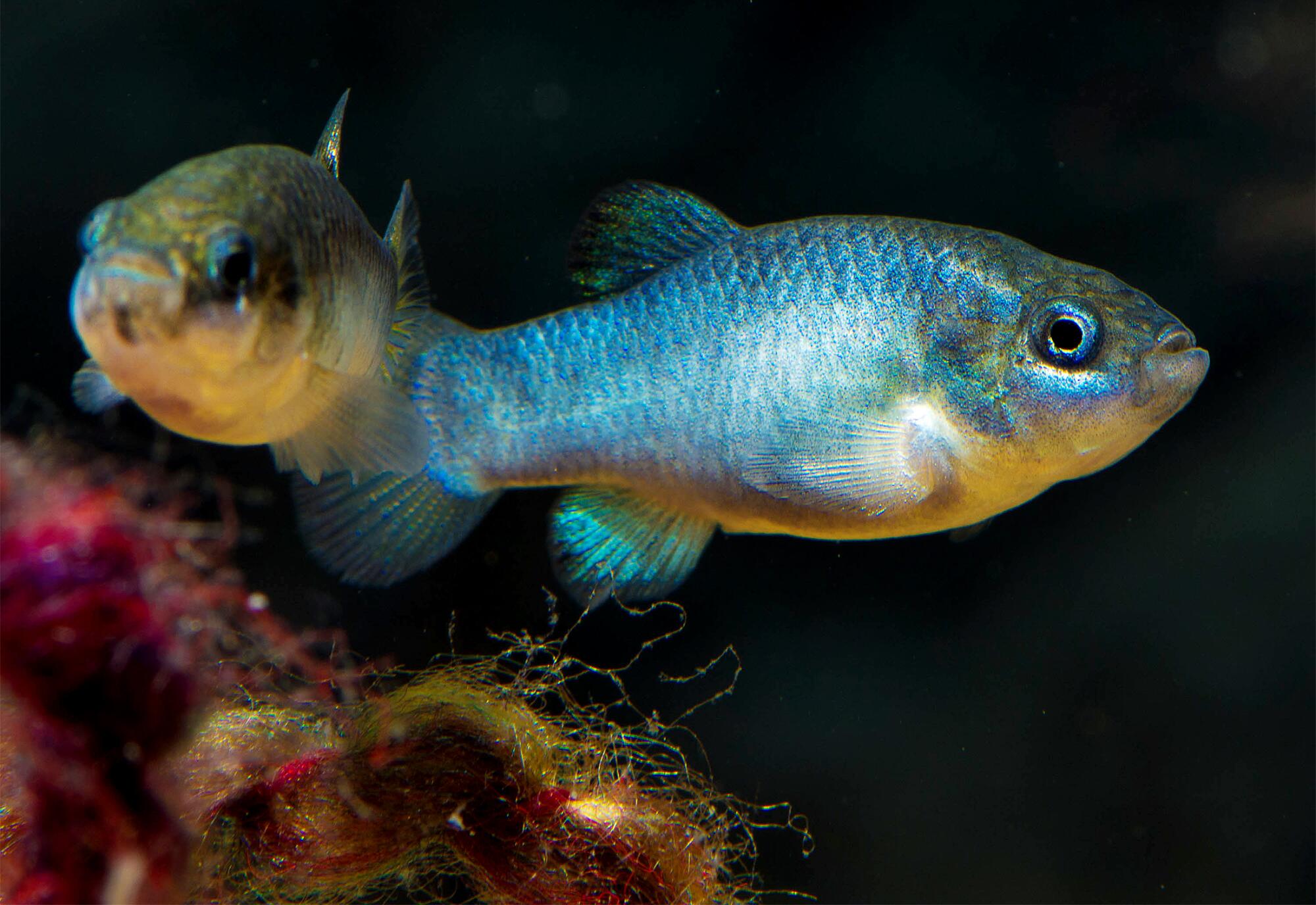
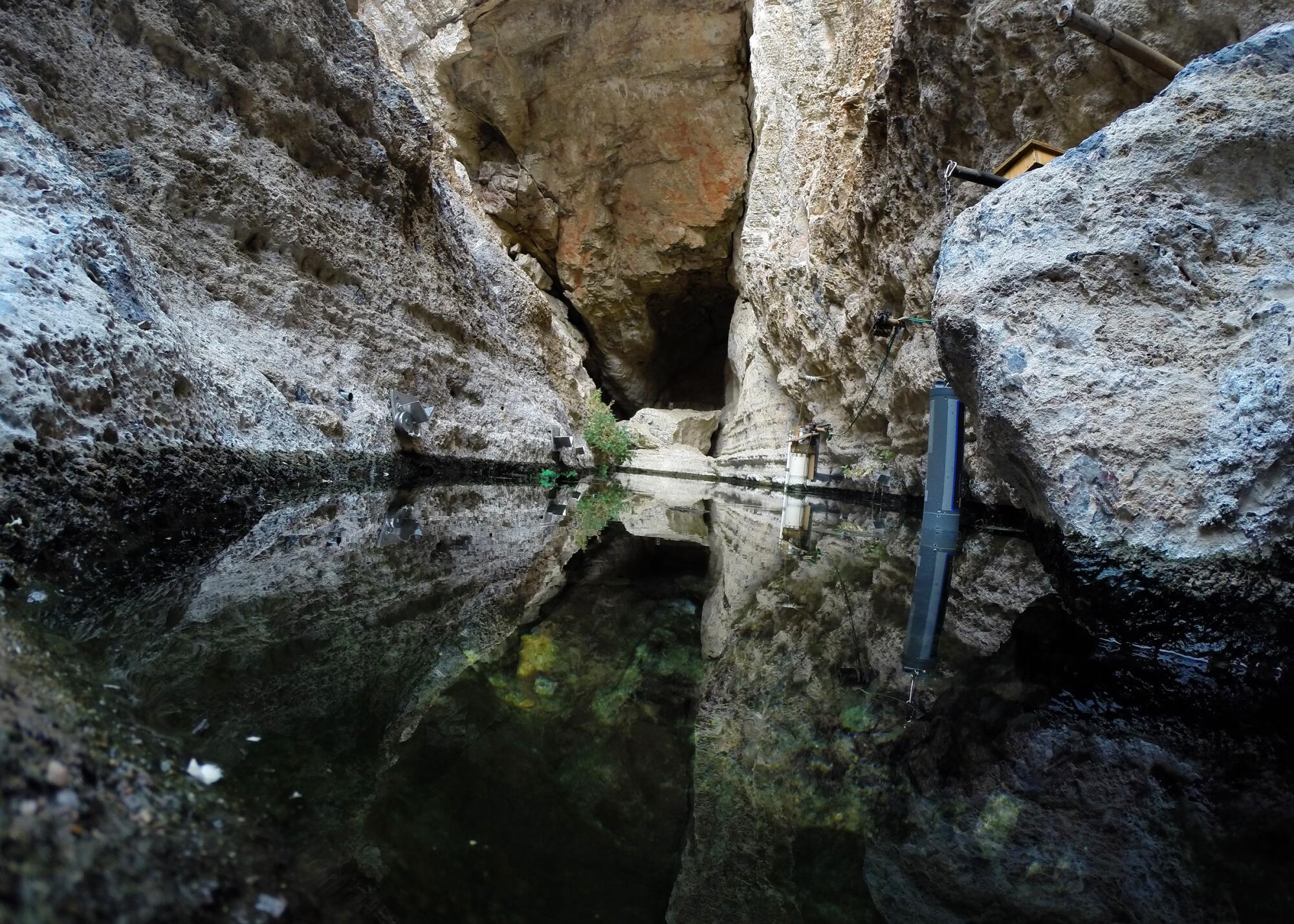
At the Ash Meadows Fish Conservation Facility in Amargosa Valley, Nev., about 20 miles northeast of the Amargosa niterwort’s stronghold, scientists have established a captive colony of Devil’s Hole pupfish — the rarest fish on Earth — in a $4.5-million, 100,000-gallon tank built as a fiberglass replica of a nearby natural rock tub in Death Valley National Park, where the species has existed since the Ice Age.
The geothermally heated water at Devil’s Hole has been a constant 93 degrees Fahrenheit, which is the upper physiological limit for the inch-long fish, which is regarded as a symbol of the desert conservation movement. But average ambient temperatures in the region have risen by about three degrees and a study by Mark Hausner, a research biologist at the Desert Research Institute in Reno, warns that another degree or two higher could destroy the Devil’s Hole pupfish’s reproduction and egg development.
Subscribers get early access to this story
We’re offering L.A. Times subscribers first access to our best journalism. Thank you for your support.
Meanwhile, a captive breeding program at UC Davis for the federally endangered Amargosa vole has improved the recovery outlook for that small mammal, only a few hundred of which cling to existence in their shrinking native wetlands east of Death Valley National Park.
Hoping to increase the vole’s odds of survival, several were captured and released into newly restored spring-fed marshes in nearby Shoshone Village, population 17, just south of the park. The wetlands also support Shoshone pupfish, a species that was considered extinct in the 1960s, but was rediscovered in the springs’ outflow in 1986.
Looking ahead, Susan Sorrels, who was born and raised in Shoshone, is among a group of conservationists campaigning to have the entire Amargosa Basin designated a national monument. “We envision stewarding an ecosystem,” she said, “where visitors to the region will be able to enjoy the stark and unspoiled beauty of this desert for generations to come.”
* * *
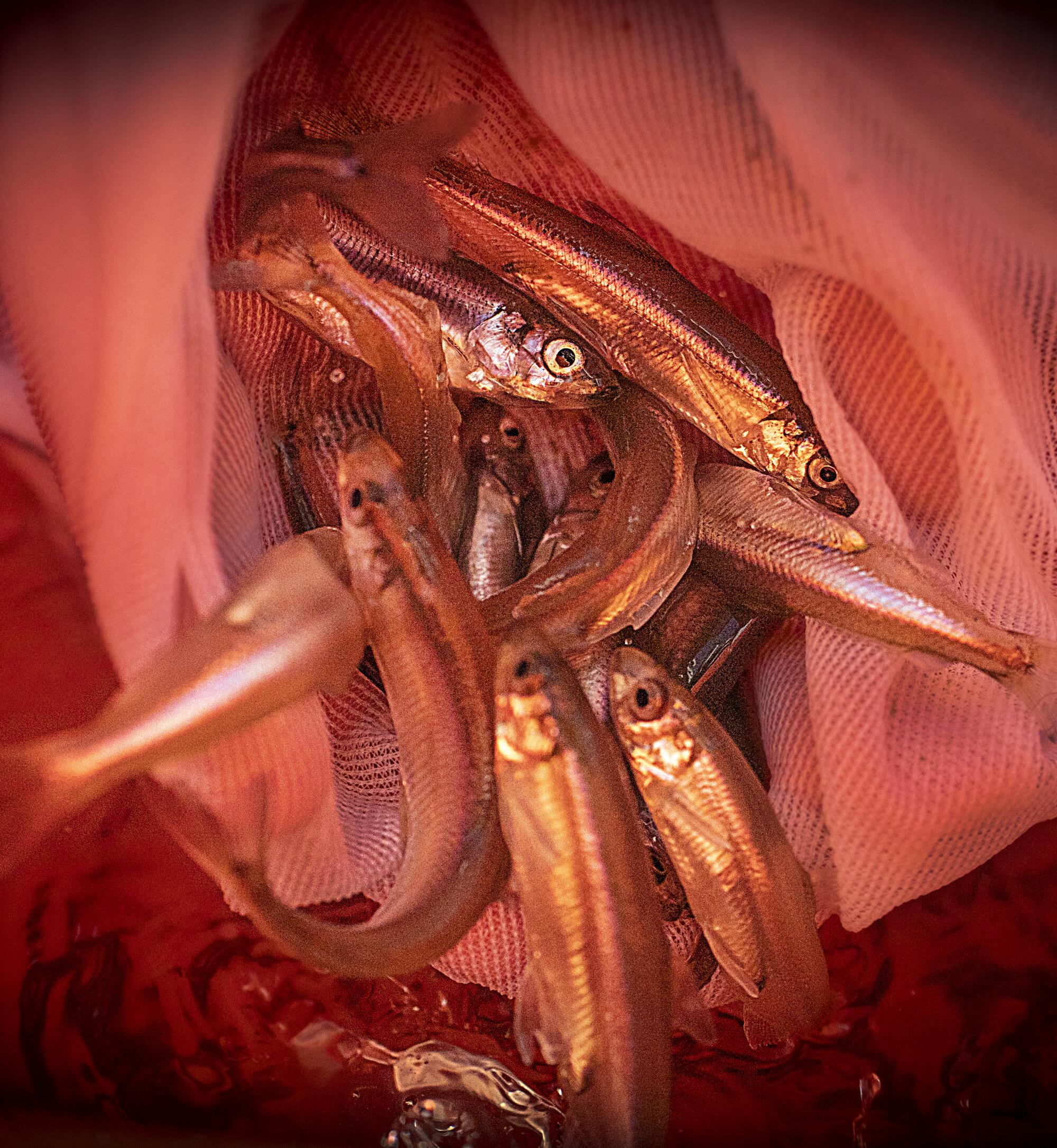
Time may have already run out for California’s most infamous fish, the 3-inch delta smelt. Experts say the fish may have disappeared from its only natural home, the Sacramento-San Joaquin Delta.
Despite a decades-long rescue effort, the delta smelt was a victim of unusually warm water temperatures combined with regulations that vexed agricultural interests and water districts and placed it squarely in the center of California’s worsening water wars.
Now, scientists say, the only places the once-abundant species still thrives is in the confines of artificial tanks at the captive breeding program at UC Davis’ Fish Conservation and Culture Laboratory, and in an exhibit at the Aquarium of the Pacific in Long Beach.

UC Davis is currently preparing to take a diminutive cousin of the delta smelt into captivity, the state threatened longfin smelt. The longfin smelt, too, has seen its population plummet over the past two decades due to a rapid decline in the environmental health of the state’s biggest estuary.
In Southern California, the largest known populations of the Pacific pocket mouse — the smallest mouse in North America — inhabit a captive breeding effort at the San Diego Zoo and a portion of the Crucible training grounds adjacent to a Marine firing range and bivouacking area at Camp Pendleton near San Diego.
Elsewhere, the Los Angeles Zoo is performing what some call miracle work by keeping alive populations of federally endangered southern mountain yellow-legged frogs, one of the rarest amphibians on Earth. Nonnative trout, fungal disease, wildfires, extreme weather and hotter stream temperatures linked to climate change have decimated the species that once thrived in the high mountains that surround Los Angeles.
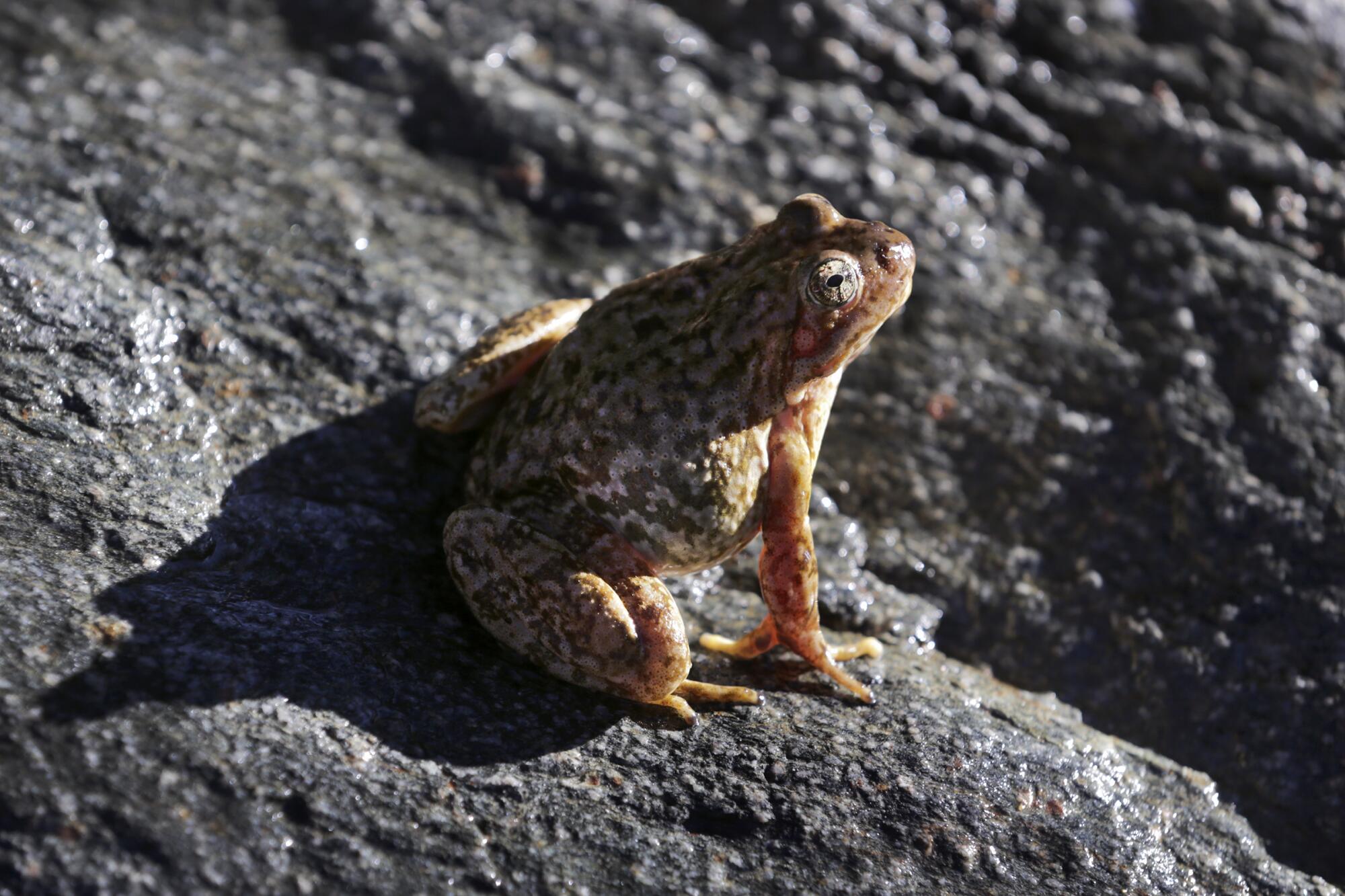
About 10 miles to the south, a weedy field overlooking an industrialized stretch of the Los Angeles River in South Gate is currently being transformed into a shady 300-foot recirculating stream for rearing rare native rainbow trout and arroyo chubs — a California species that adapted easily to most conditions, except for extreme drought, mudslides and urban development.
Watching western monarch butterflies flutter into extinction remains a disturbing possibility. Only an estimated 1,914 monarch butterflies wintered on the California coast over the past year — the lowest number ever recorded and an indication that climate change and pesticide use are disrupting flowering seasons in stands of milkweed and wildflowers needed to complete their migration to central Mexico.
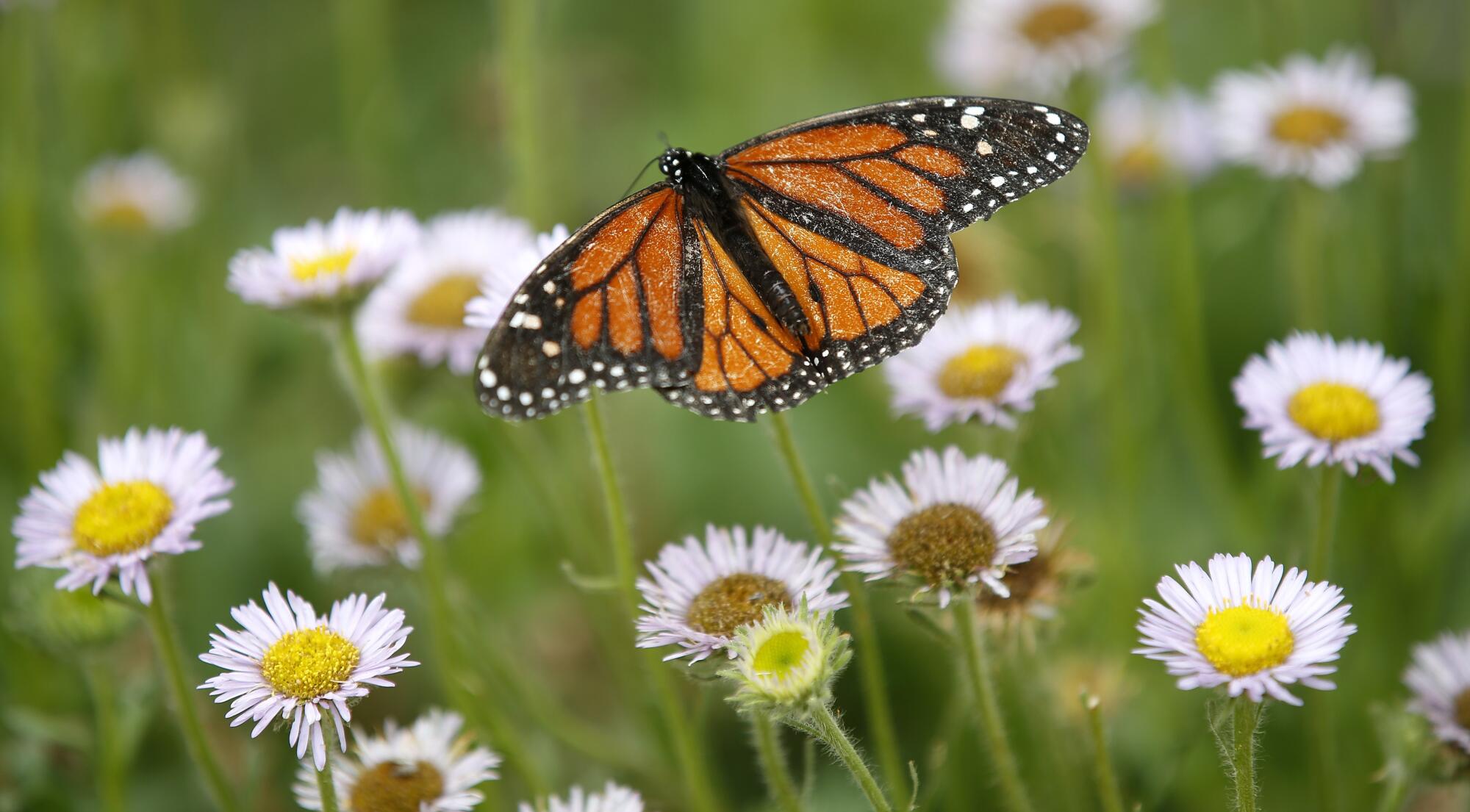
Now, the Center for Biological Diversity is calling on Interior Secretary Deb Haaland to immediately use her emergency authority under the Endangered Species Act to designate all or portions of the 36 national wildlife refuges in California as pesticide-free monarch safety zones and provide funding for massive plantings of milkweed and nectar plants.
Separately, a coalition of environmental groups led by the nonprofit River Partners and the state Wildlife Conservation Board is restoring over 30,000 milkweed plants at eight sites from Oroville Dam in the Sierra Nevada foothills east of Sacramento south to the Hollenbeck Canyon Wildlife Area just east of San Diego.
“Monarchs are wedded to waterways,” said Julie Rentner, president of River Partners, “so, when California and the West get hit with tough droughts and prolonged, record-breaking heat waves, monarch populations suffer big time. We are pulling all the actionable levers we can to save this iconic species from an avoidable demise.”
Then there is the California Botanic Garden, which is trying to build seed banks of the rarest plants in the state. As part of that initiative, it has installed additional seed bank freezers equipped with emergency backup generators and has seismically upgraded the building that houses them.
“So far, we’ve gathered seeds from about 20% of the state’s rarest plants,” Fraga said. “But the heartbreaking reality is that some plants won’t be able to survive another year as dry as this one. We went out this spring and couldn’t find a single flower with viable seeds anywhere in the Mojave Desert.”
Nick Jensen, Southern California conservation analyst with the California Native Plant Society, was not surprised. “For many plant species in the desert, it’s boom or bust,” he said. “They germinate while it’s moist, grow in the spring and, if conditions are right, they flower and generate seeds.
“But they just won’t open their doors for business in a real dry year like this one.”
* * *
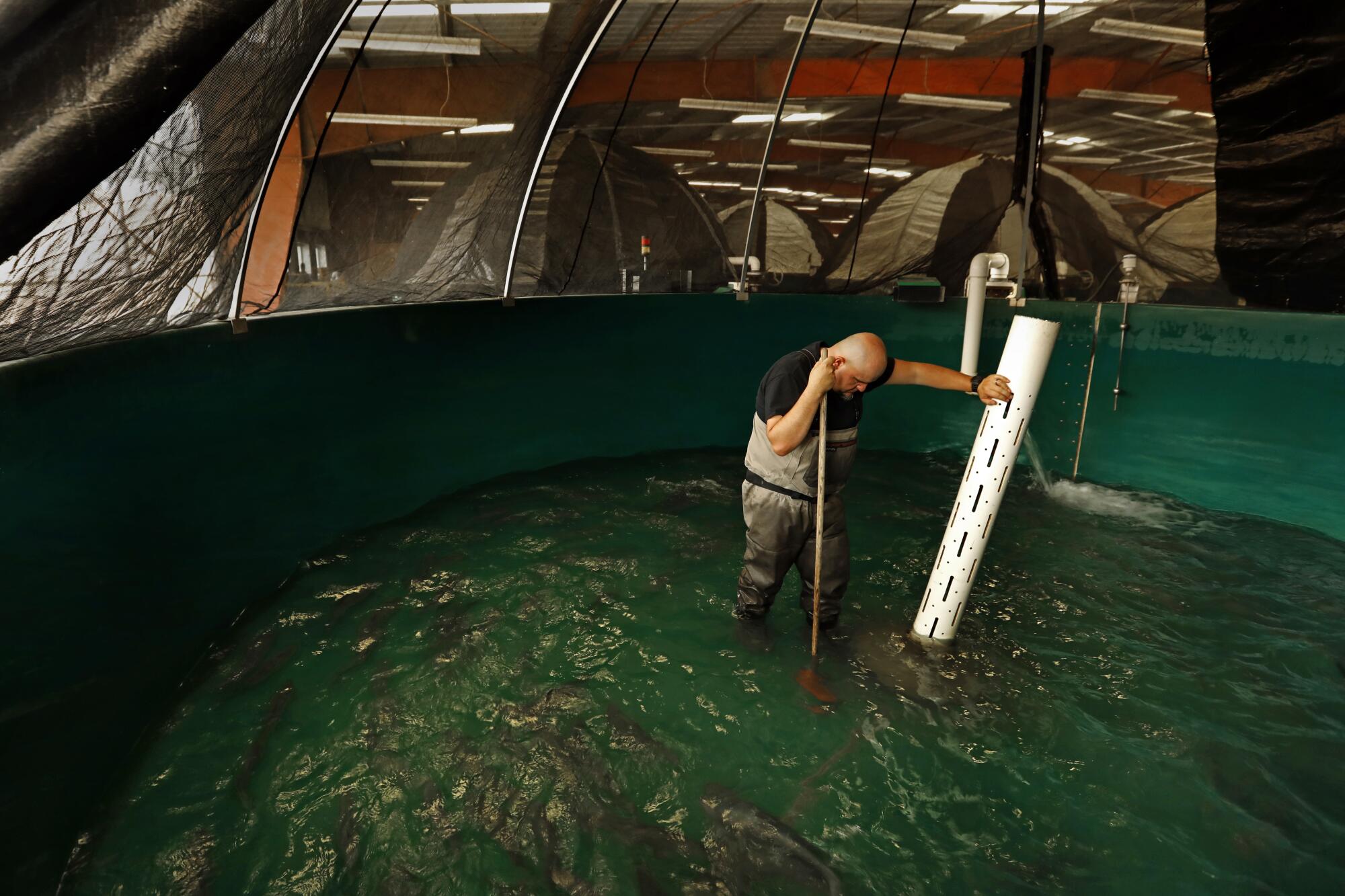
In an unprecedented salmon salvage operation in April, the California Department of Fish and Wildlife trucked about 16 million juvenile fall-run chinook salmon from four Central Valley hatcheries to the Bay Area and offshore net pens, bypassing more than 100 miles of historically low and warm river conditions.
The massive trucking operation was “designed to ensure the highest level of survival for the young salmon on their hazardous journey to the Pacific Ocean,” said Jordan Traverso, a spokeswoman for the department. “It’s an extreme set of cascading climate events pushing us into this crisis situation.”
It took 146 individual trips traveling more than 30,000 miles between April and June to relocate the fish as part of an effort to support California’s $900-million commercial and recreational salmon fishing industry, officials said.
But critics warn that captive breeding is a Faustian bargain. In stark terms, they can result in new generations of species that lack the genetic diversity and strength to survive in the unpredictable conditions of the wild.
In Northern California, for example, during some releases, hatchery-bred salmon have thrived. But modest changes in food supply and water temperature can wipe out hatchery stock.
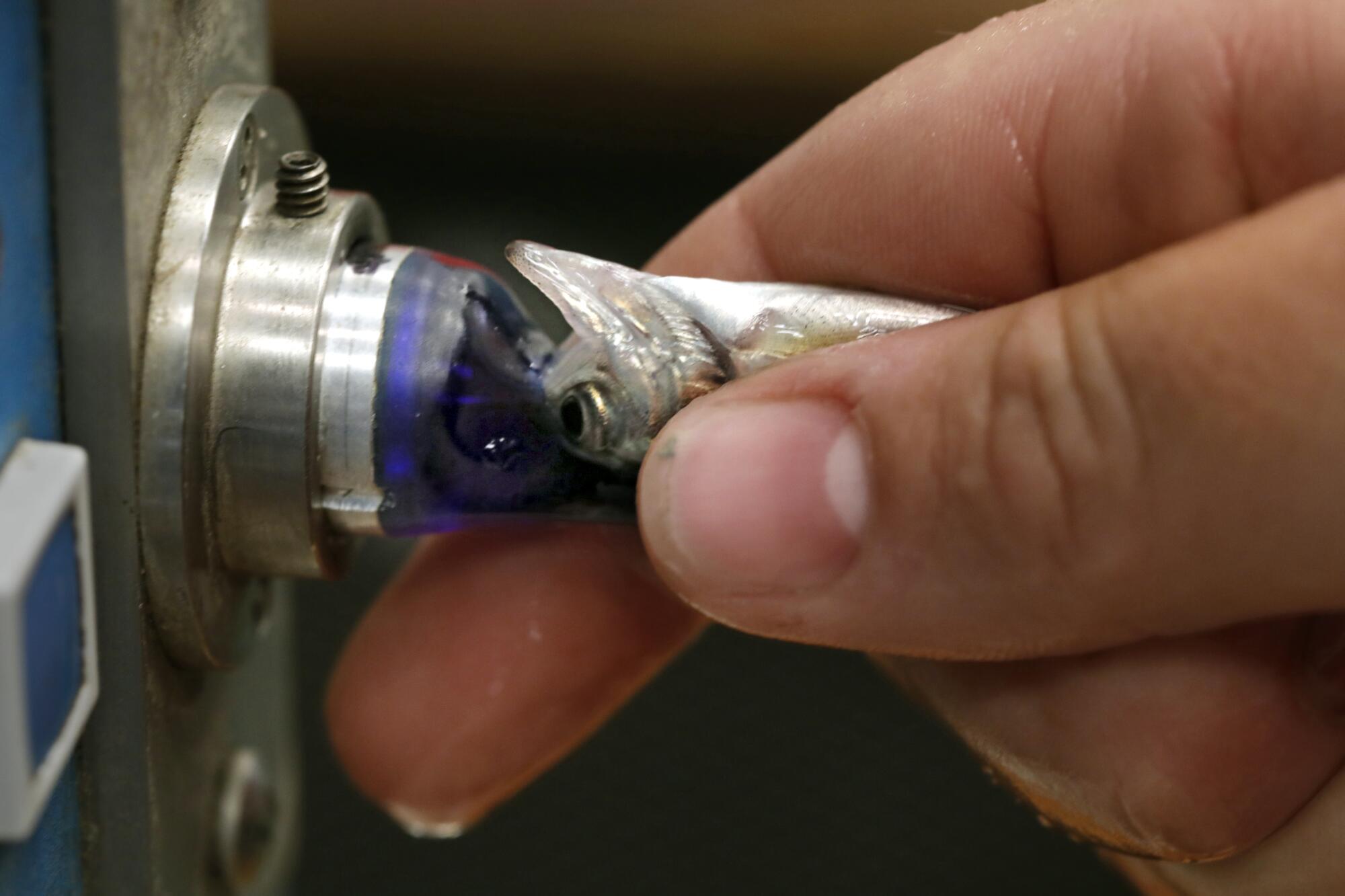
But never has the need to save salmon, the red-fleshed symbol of abundance and vitality in the rivers along the coasts of California, Oregon and Washington, been so urgent.
Today, these fish are extinct in Southern California, and most of those that remain in the region are supplemented by hatcheries because of the deteriorating conditions of their freshwater migratory routes to the ocean and spawning grounds — in some cases hundreds of miles from the sea.
Idaho biologists are trucking Snake River sockeye upriver this summer, trying to save them from record-breaking Northwest heat.
The frantic rescue efforts now underway to save the cold-water fish steeped in mystery and heavenly when grilled over alder illustrate how tenuously it is clinging to life as climate change takes a toll on ancient watersheds and hatcheries alike.
“My weekly grind these days is moving salmon from one hatchery to another — a situation that never happened before,” lamented Ben Harris, executive director of the Monterey Bay Salmon and Trout Project. “Almost every hatchery in the state is facing deteriorating conditions right now.”
A year ago, Harris helped evacuate about 30,000 federally endangered coho salmon fry and a few hundred prize brood stock fish after the CZU Lightning Complex fire ripped through the century-old Kingfisher Flat Hatchery in Sonoma County.
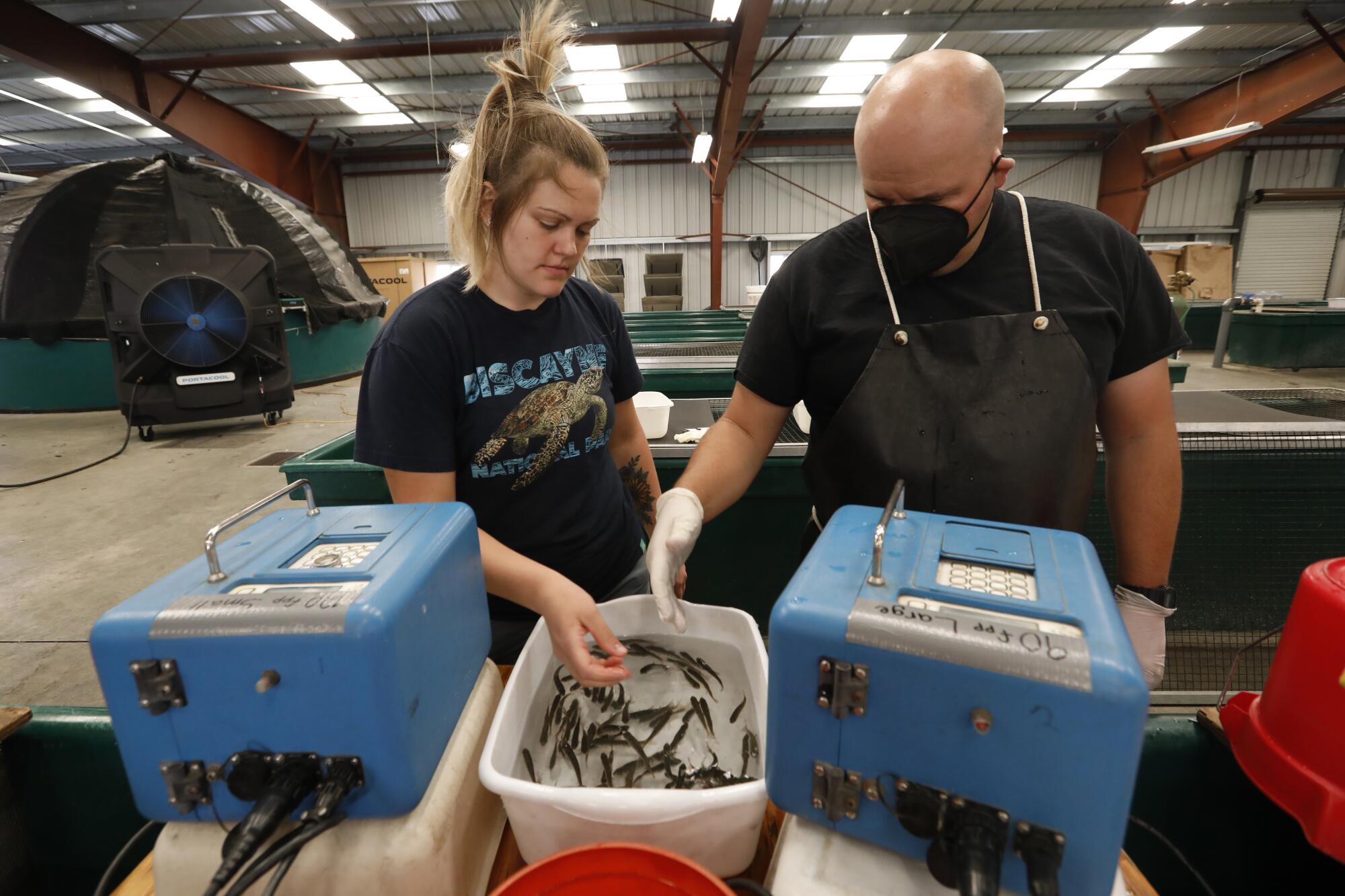
The survivors were transported by tanker trucks to the Warm Springs Hatchery in Geyserville, a U.S. Army Corps of Engineers facility at the base of the dam at Lake Sonoma. It has a reputation as an emergency shelter for displaced hatchery fish.
This year, however, the water level in Lake Sonoma has dipped so low that biologists are worried that the unusually hot summer will raise the temperature of its flows into the hatchery’s 20-foot diameter fiberglass tanks — making the water too warm for the salmon to live.
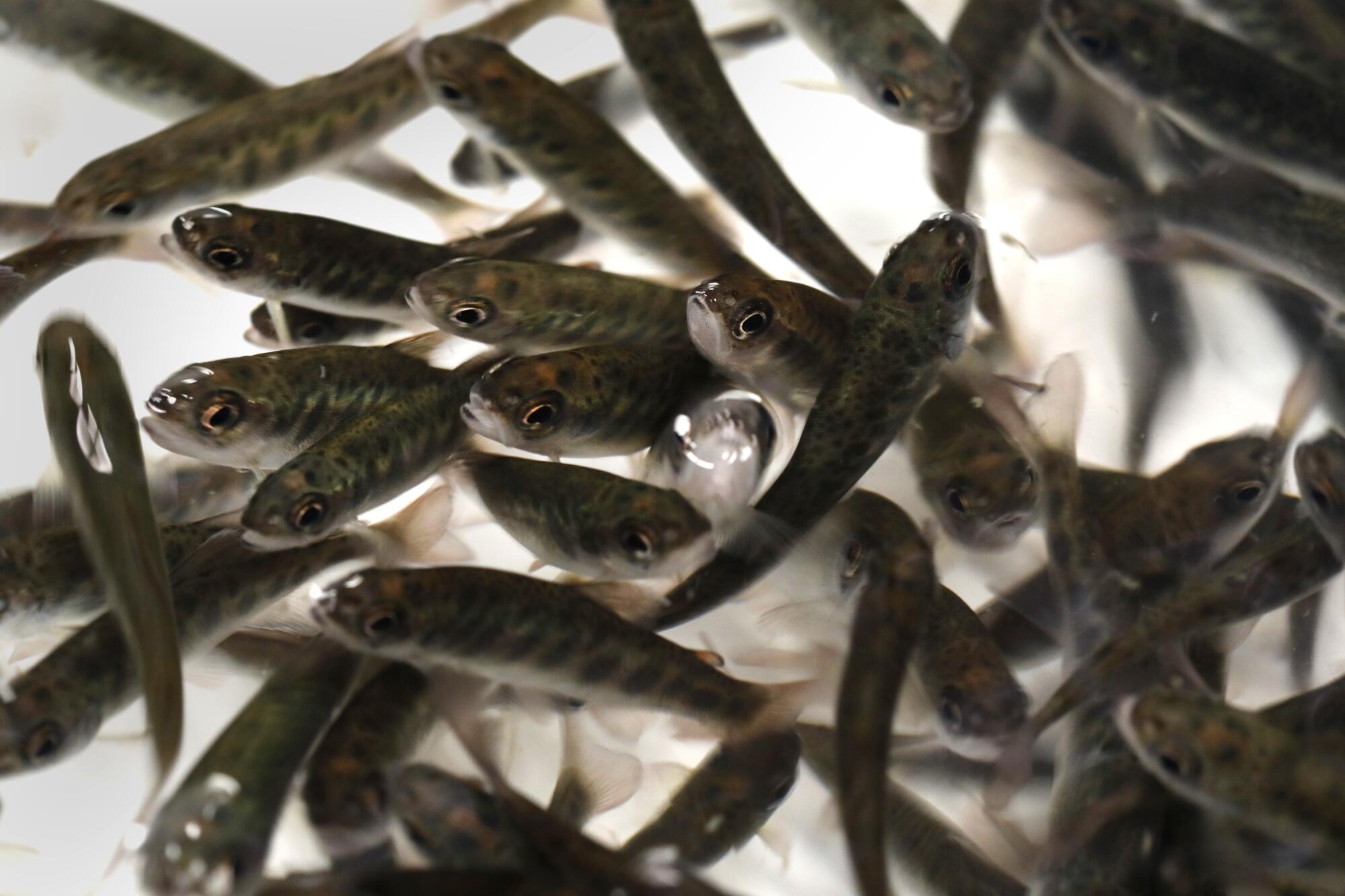
Now, hatchery officials are preparing to move about 20,000 coho salmon, including many of those rescued at Kingfisher Flat, by tanker truck to the only facility within a hundred miles likely to keep the sensitive fish healthy: the small Casa Grande High School fish hatchery in Petaluma, about 40 miles to the south. That hatchery relies on cold water pumped up from an underground aquifer.
On a recent weekday, Ben White, manager of the coho salmon recovery program at Warm Springs, gazed into a tank boiling with frisky, 2-pound brooders used for spawning and sighed.
“It’s ironic, isn’t it?” he said. “We’re considered a backup facility for troubled hatcheries. Now, we’re in a serious predicament, but we have no backup — and there aren’t a lot of options.”
A proposal to spend millions of dollars on a massive water-chilling system was jettisoned, in part because, as one federal biologist put it, “chillers guzzle diesel fuel and aren’t exactly a ‘green’ technology.”
Coho Salmon at Warm Springs Hatchery in Geyserville.
Releasing hatchery salmon directly into the wilds is out of the question. “Rivers and tributaries throughout the region are dry, or on the verge of going dry,” White said, “and infested with toxic algae blooms and deadly parasites.”
Earlier this month, in the western Sierra Nevada range’s Butte Creek, about 100 miles to the north, over 12,000 adult Central California spring run chinook salmon died prematurely before spawning due to heat-related oxygen deficiency and the outbreak of fish diseases.
“Our plan is simply this: move as many coho salmon as possible to the high school hatchery and leave the rest here in our tanks,” he said. “We might lose some fish as a result, but we can’t just sit on our hands and do nothing.”
The action has inadvertently placed Casa Grande High staffers and students on the front lines of the battle to save an endangered species that once nourished the good life of the Northwest.
“A federal emergency has fallen on our doorstep, which is incredibly exciting,” said Dan Hubacker, a science teacher at the school and director of the nonprofit United Anglers of Casa Grande. “Our students can help fix it.”

In a separate operation, state wildlife authorities in April relocated 1.1 million juvenile, fall-run chinook salmon by truck from the Iron Gate Fish Hatchery in Siskiyou County to the Trinity River Hatchery about 122 miles away, where the fish will remain until conditions in the Klamath River improve.
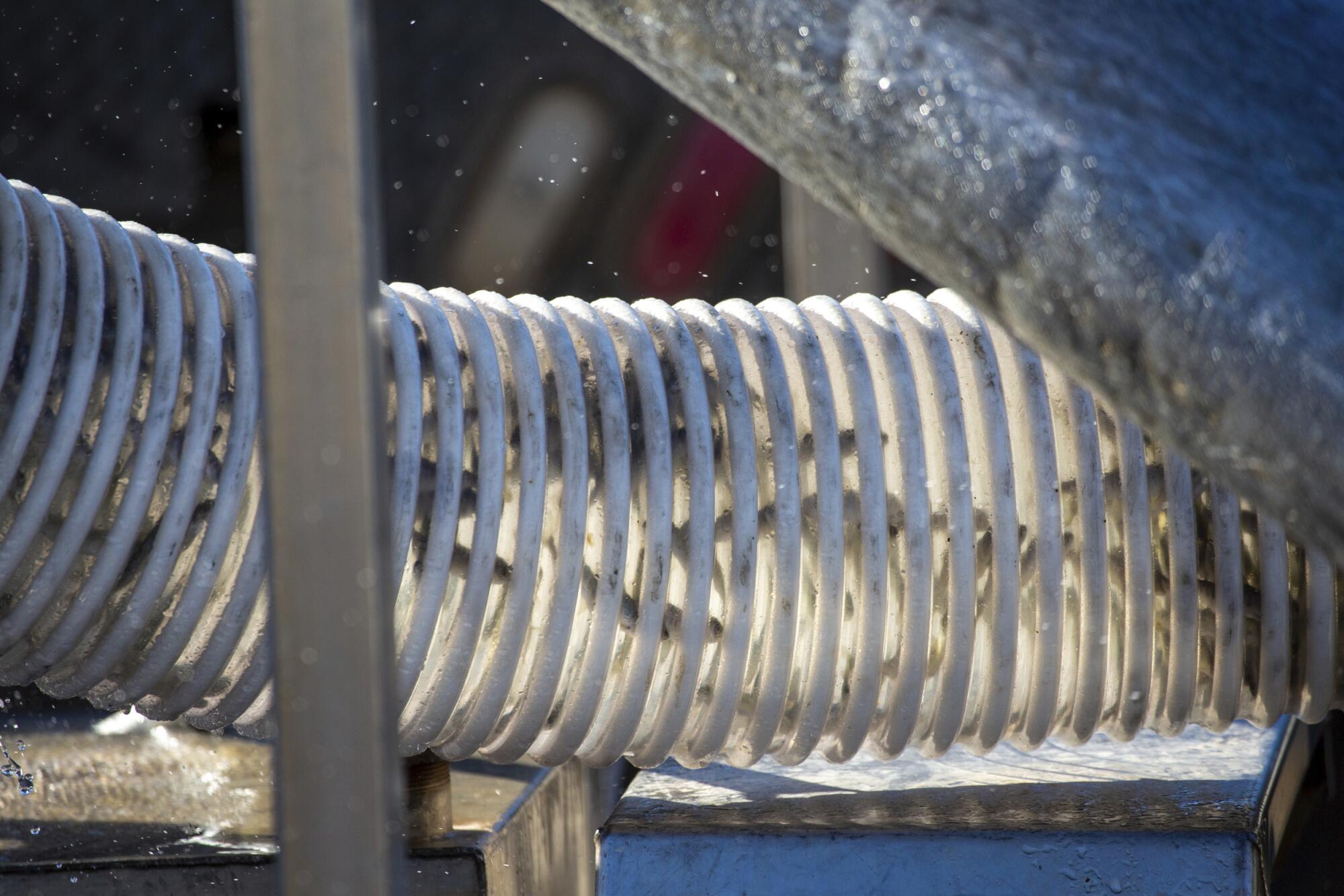
The salmon, about 7 months old and 3 inches long, are normally released into the Klamath River in May and June. The move to the Trinity River Hatchery was prompted by warm water temperatures, low water flow and an exceedingly high probability of salmon succumbing to disease in the Klamath River. It marks the first time Iron Gate has not released salmon into the Klamath since it was built in 1962.
“It’s extremely challenging to raise cold-water fish species in a drought,” said Mark Clifford, a hatchery environmental scientist for the agency’s Northern California region. “The reality is most of these fish would have died if we released them into the river. We need to maintain the integrity of the fall run on the Klamath River and we especially can’t afford to lose this generation of fish.”
All the relocated salmon have been outfitted with unique coded wire tags to allow state biologists and other agencies to determine their origin and destination. In addition, their adipose fins have been removed to visibly identify them as hatchery-reared fish.
Four Klamath River dams are slated for removal by 2024, the largest dam removal undertaken in U.S. history. The removal is expected to rejuvenate the river and help contribute to future generations of wild salmon prosper.
In the meantime, the Northwest has found itself on the brink of panic over the outcome of ongoing rescue efforts that could decide the fate of salmon, an important economic resource to the region with a powerful constituency of commercial fishermen, naturalists and Native American tribes: the Yurok, Hoopa, and Karuk.
* * *
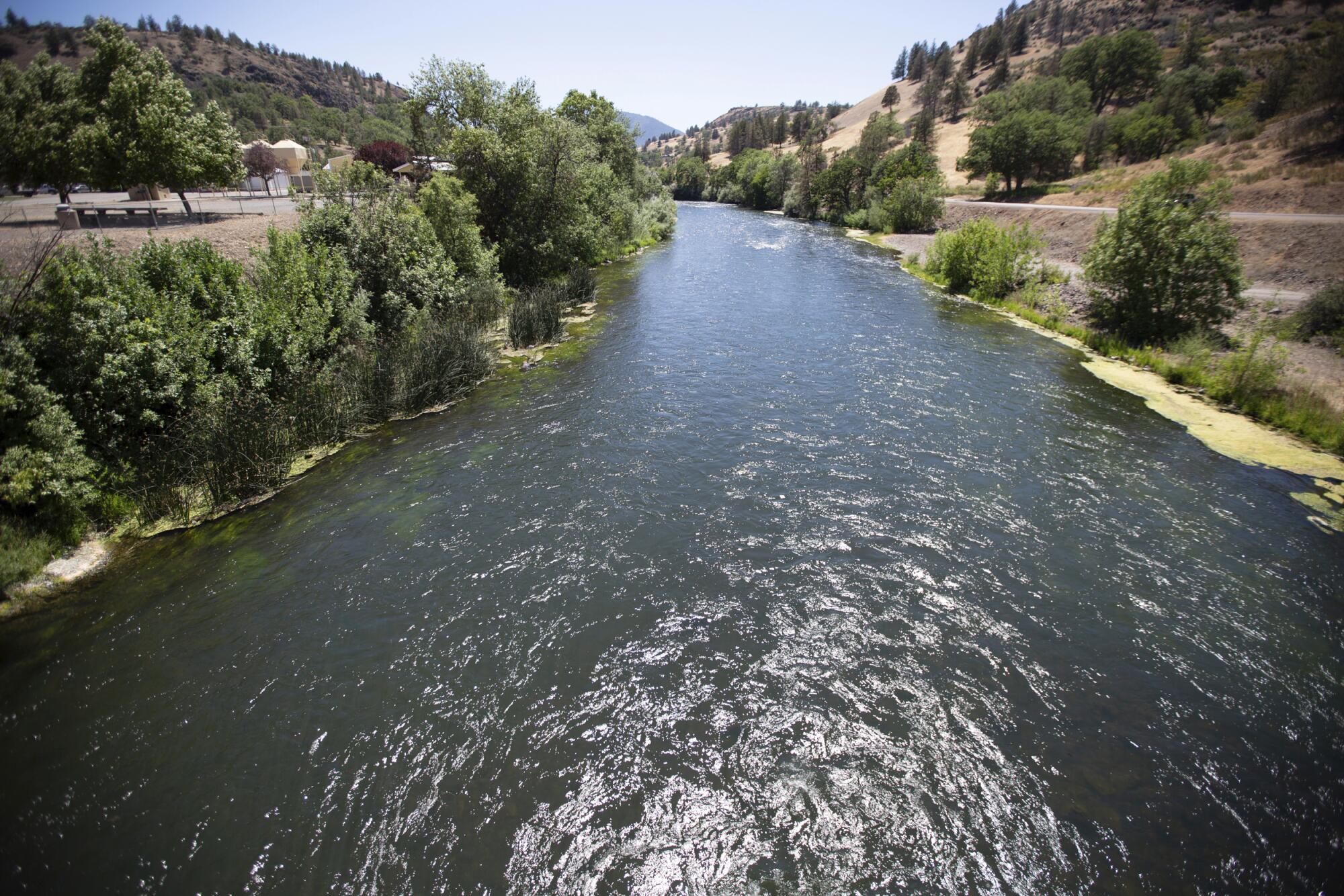
Late summer used to be a season of wonder at the confluence of the Klamath and Salmon rivers in far Northern California, about 60 miles upstream from the Pacific Ocean. As they have throughout their history, Karuk Indians gather there each summer to give thanks for the bounty of the Earth, and to catch wild salmon.
Like buffalo for the Native Americans of the Great Plains, salmon have been crucial to the survival and social structure of the Karuk. Their most important social gatherings are ceremonies to pray for balance in nature and to honor one of nature’s most dramatic migratory journeys: mature salmon fighting their way upriver to where they hatched, so they could spawn and then die.
Sitting on a log on a ridgeline a few weeks before this year’s gathering, tri6bal member Troy Hockaday gazed out over the drought-stricken flows edged with lichen-clad boulders, maple trees and oaks, and shared memories of the old days, and better times.
“For the Karuk, this place is literally the center of the universe,” he said. “Our people have been catching salmon here for thousands of years.”
“More recently, as a boy,” he added with a laugh, “I caught salmon up to 4 feet long with my bare hands. We called them ‘June hogs.’ And man, they were fat, juicy and delicious.”
At 55, Hockaday is a charismatic Karuk Tribal Council member. But more important, at least when the salmon migrate, he is one of a shrinking group known as traditional dip net fishermen.
He and the others shoulder the responsibility of providing traditional food and keeping alive the ancient rite of Karuk culture: the catching of the salmon with fishing nets attached to hand-held poles.
But what about now?
The two-year dry spell and record-breaking heat waves have made Northern California rivers too low and too warm to sustain migrating salmon. A pall of wildfire smoke hangs over the vast Klamath watershed as its forests turn brittle, rivers shrink and rates of parasitic infection in wild and hatchery-raised fish soar.
A recent fish survey on 60 miles of the Salmon River had a heartbreaking outcome: Only 95 spring-run chinook salmon were counted — the second-lowest census since 1990, according to the nonprofit Salmon River Restoration Council.
“Here’s the deal,” said Craig Tucker, natural resources policy advocate for the Karuk. “Some of our once-mighty rivers resemble dirt roads with puddles on them. And each one of those puddles is full of stranded endangered salmon.”
“Like Orange County’s vanishing oranges,” he mused, “there’s only a few dozen salmon left in the totemic Salmon River.”
Hockaday wouldn’t argue with any of that. Surveying the confluence that remains the single most sacred site of Karuk culture, Hockaday looked like a person watching his neighborhood deteriorate into a blighted landscape.
“All I want,” he said, “is to be 80 years old and watching my grandkids scooping up wild salmon with dip nets for the tribe.”
* * *
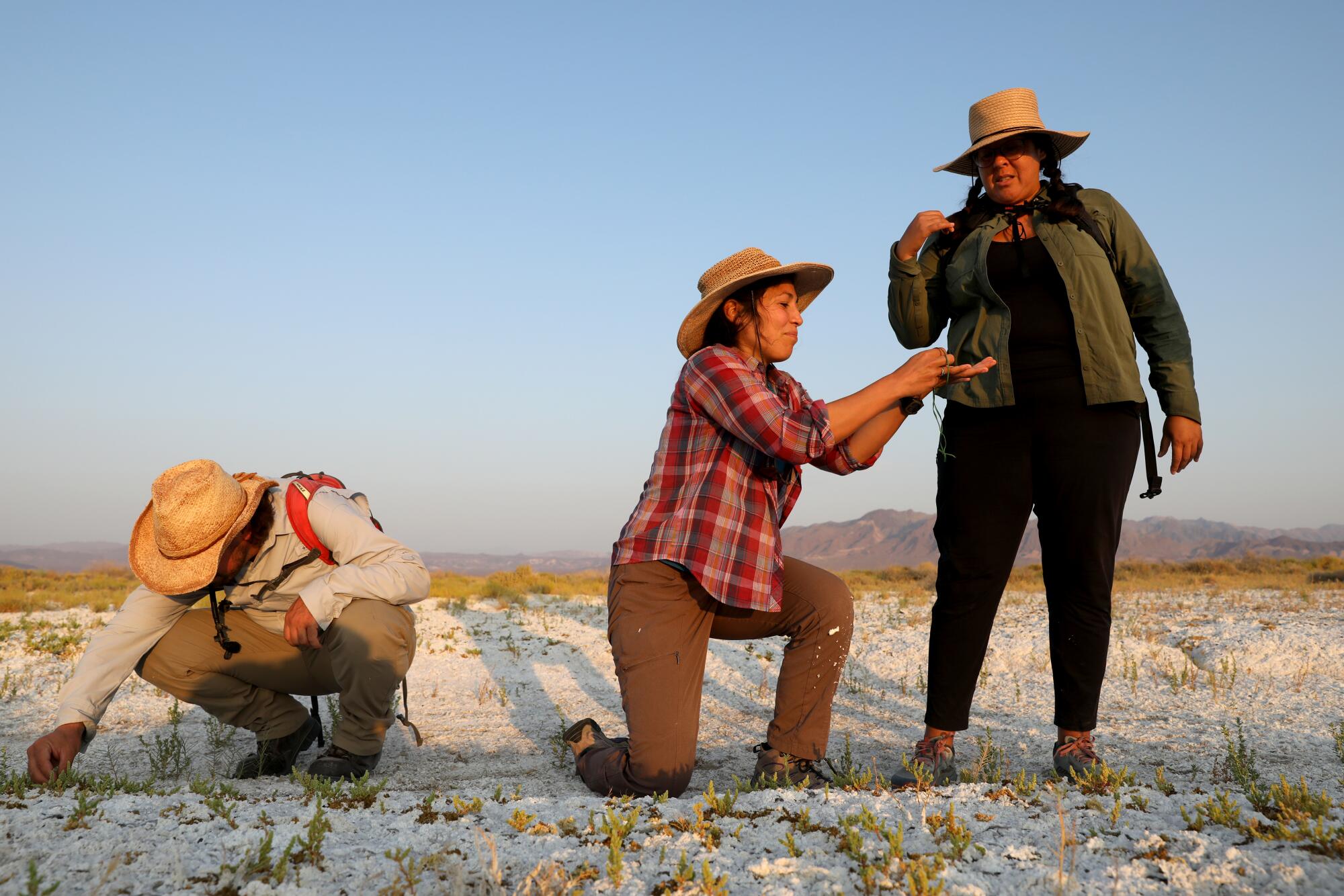
Out in the Mojave Desert, it was 8 a.m. and already as hot as a blast furnace when Fraga came to an abrupt stop and nodded appreciatively toward colonies of 3-inch-tall green plants surrounded by pebbles, sand and clumps of salt grass.
“There’s some of our guys,” said Fraga with a smile.
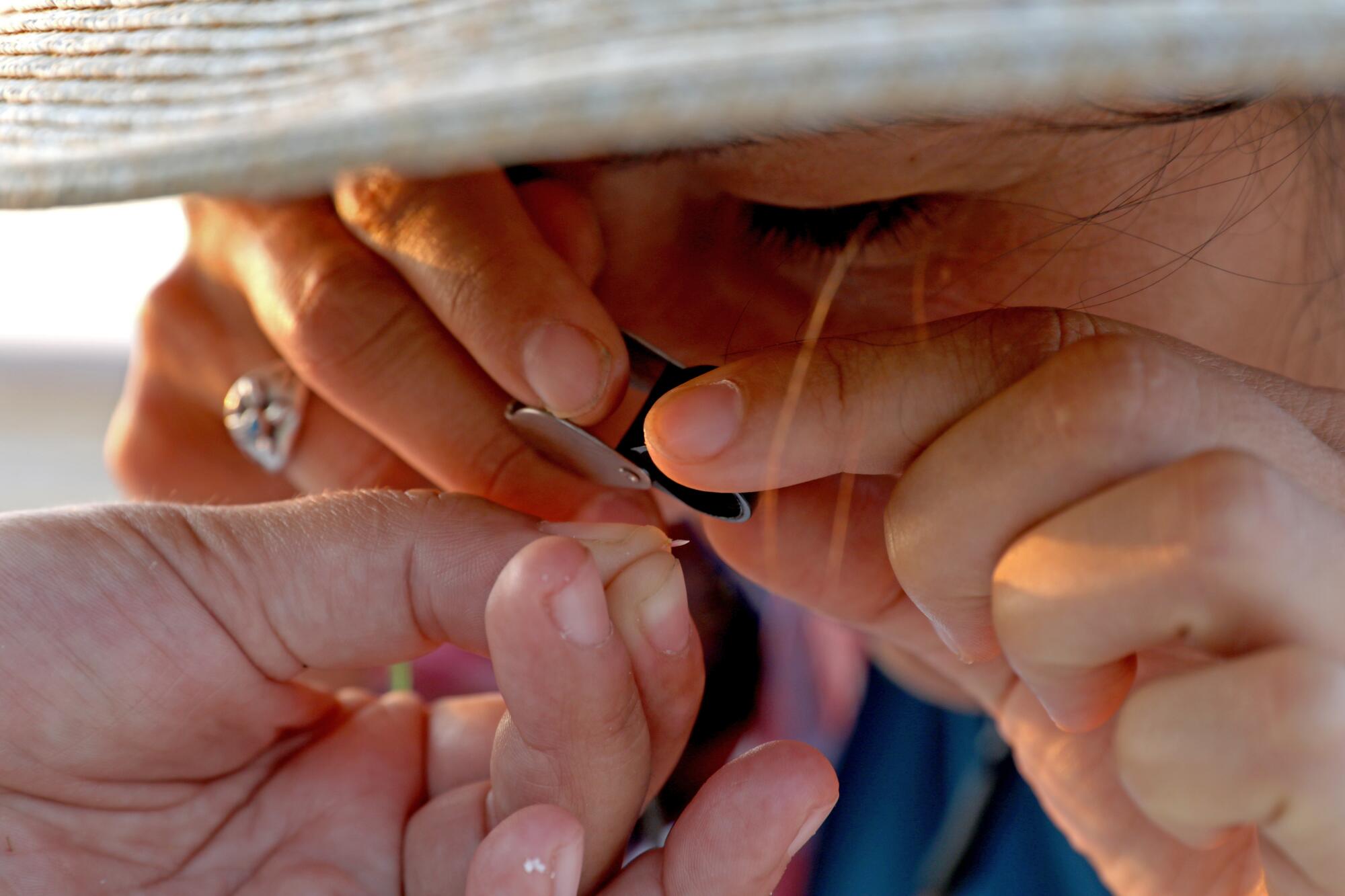
Dropping to her knees, she plucked a pink fruit slightly smaller than a green pea, cracked it open and then frowned.
“Each fruit can produce one seed,” she said. “But in this case, there’s nothing inside. Nothing at all.”
A few yards away, Jesus used a magnifying glass to assess the health of two seeds she had extracted from the fruit of a nearby plant. Her glum prognosis: “These seeds are not viable.”
“Amargosa niterworts may seem inconsequential to some people,” Fraga said, prying open yet another fruit. “But they’re resilient, tough little guys clinging to existence in one of the harshest environments on Earth.”
Suddenly, beaming like a kid with a new bike, she announced, “I’ve got a good seed! It is firm to the touch. Not dry.”
She tucked the seed into a small envelope as carefully as if it were a raw diamond.
Fraga pivoted on her boot heels and sighed with sadness over the seemingly endless drought and the possible salvation of the lowly species whose lone seed she and Jesus would carry home.
Extending her arms as if to embrace the tiny patches of green clinging to existence on the parched white flats, she announced a change of plans.
“The good guys in this battle need every seed they can muster to survive another generation in the wild,” she said. “Let’s call it a day.”
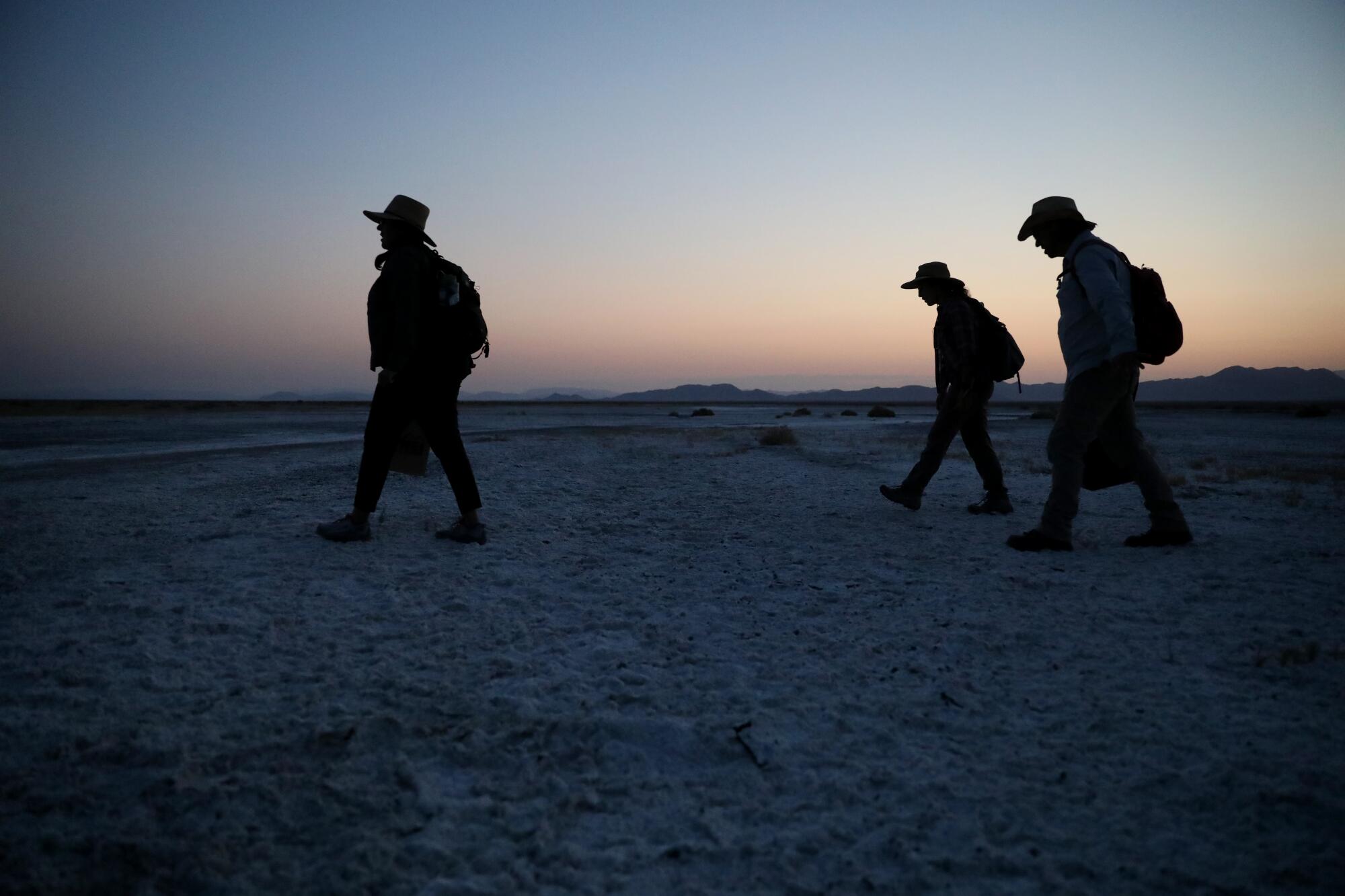
More to Read
Sign up for Essential California
The most important California stories and recommendations in your inbox every morning.
You may occasionally receive promotional content from the Los Angeles Times.
